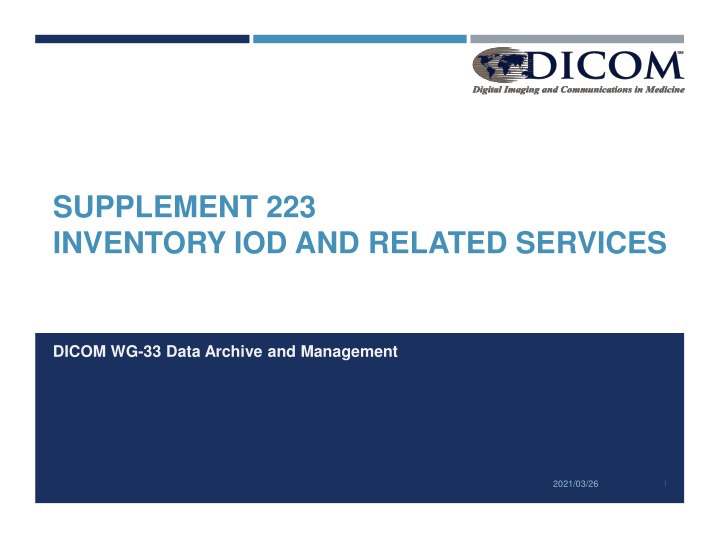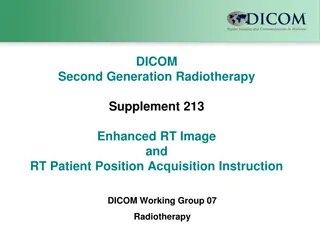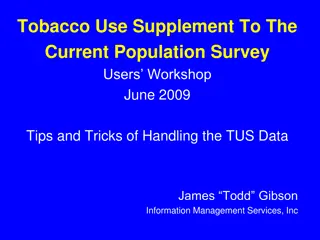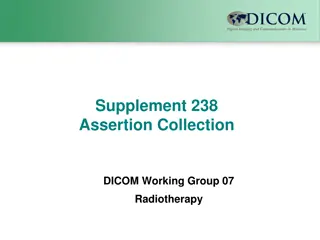SUPPLEMENT 223INVENTORY IOD AND RELATED SERVICES
The supplement addresses the critical need for standardized inventory production in DICOM repositories, particularly for PACS migration. It covers the establishment history of WG-33, primary use case of PACS migration, and how Sup.223 supports inventory object services for various use cases like clinical research and business analytics.
Download Presentation

Please find below an Image/Link to download the presentation.
The content on the website is provided AS IS for your information and personal use only. It may not be sold, licensed, or shared on other websites without obtaining consent from the author.If you encounter any issues during the download, it is possible that the publisher has removed the file from their server.
You are allowed to download the files provided on this website for personal or commercial use, subject to the condition that they are used lawfully. All files are the property of their respective owners.
The content on the website is provided AS IS for your information and personal use only. It may not be sold, licensed, or shared on other websites without obtaining consent from the author.
E N D
Presentation Transcript
SUPPLEMENT 223 INVENTORY IOD AND RELATED SERVICES DICOM WG-33 Data Archive and Management 2021/03/26 1
History WG-33 established by DSC December 2019 In response to Laitek proposal from April 2019 Organizational meeting January 2020 Elected officers: Matt Bishop, user co-chair; Keith Ecklund, vendor co-chair Substantive work began March 2020, with broad user and vendor participation 20+ participants per bi-weekly meeting typical Consensus technical approach agreed August 2020 Discussed ~24 major technical issues (see Closed Issues in Sup 223 draft) Work Item approved by DSC August 2020 Draft Supplement approved for Public Comment by WG-6 March 25, 2021 2021/03/26 2
Primary Use Case PACS migration Users typically replace PACS after ~12-15 years, often with change of vendor Became a significant user (PACS administrator) concern in 2010 s Institutional consolidation often requires merge of disparate PACS Replacement/consolidation requires migrating historical data to a new system Digital storage often retained forever Volumes increasing with hi-res, 3D/4D, and multimodality studies Many institutions store > 109 instances with data volumes > 1015B (petabyte) Performance at scale is challenging DICOM Query/Retrieve designed for accessing relatively small number of studies Need mechanisms that account for enterprise-scale data operations 2021/03/26 3
But Sup 223 is not a PACS migration standard PACS migration is a multi-faceted endeavor, some aspects of which can be supported by DICOM standards, and others that cannot Sup 223 addresses one critical need to support migration production of a standardized inventory of the DICOM content of a repository Required to prepare for migration, and to validate completeness of migration Many other processes involved in execution of migration Sup 223 is a standard for Inventory IOD and related services Inventory object and services may also support other use cases 2021/03/26 4
Secondary Use Case Clinical Research and Business Analytics Inventory can be important data source (in conjunction with EMR and image instances) for research and analytics Representation of the PACS database in standard non-proprietary format Can be searched or processed without impacting PACS in clinical operation Transferrable to research IT system (data warehouse) extract in paradigm of Extract/Transform/Load (E/T/L) Inventory may be produced for a specified census of candidate patients, with further selection based on modality or study or series description De-identification as required in research not in scope of Sup 223 De-ID is part of E/T/L transform , and highly dependent on merge process with other data sources 2021/03/26 5
Secondary Use Case Safety Backup Image access is a patient safety / mission critical resource PACS DBMSs typically have fault tolerant designs E.g., redundant online storage and offline backups But data is in proprietary format and dependent on the DBMS for effective use DBMS becomes single point of failure May become inoperable, e.g., due to license key expiration or malware attack Inventory is a DBMS-independent replica of the critical data content of the PACS database for the managed DICOM SOP Instances If the repository instances are in DICOM File Format and referenced in the inventory, there is a complete alternate path to access the images 2021/03/26 6
Secondary Use Case Quality Control Inventory may be produced for studies missing critical attribute values Patient ID, Accession Number, Study Date Allows proactive correction Comparison data for wellness check (continuous testing) of PACS operation C-FIND result for sample of studies compared to data in previous inventory (e,g., metadata, number of images) C-MOVE retrieve objects compared to direct filesystem access objects Message digest (MAC) computed on objects retrieved through filesystem compared to MAC in previous Inventory 2021/03/26 7
Overview of Sup 223 2021/03/26 8
Sup 223 focus - inventory object Inventory of entire PACS archive (or described subset) in non-proprietary format IOD with hierarchical structure based on DICOM information models Encoded using DICOM formats and data structures Inventory written to persistent objects (SOP Instance(s) / files) Accessible asynchronously Functionally equivalent (+/-) to Query (C-FIND/QIDO) response for entire PACS database But Query typically has restrictions on number of responses Query requires synchronous network protocol response, infeasible for a billion records 2021/03/26 9
Client PACS database Archive Data Store Inventory Inventory is representation of PACS DB provided to client 2021/03/26 10
1 1-n Inventory Equipment creates 1 references 0-n Study 1 1 1 has subject has context has component 1 0-n 1 Imaging Service Request 1 Patient Series 1 has component Inventory Information Entity-Relation Model Compare to Query Study Root Information Model 0-n Instance 2021/03/26 11 Access mechanisms / links
Inventory IOD Structure SOP Common attributes Equipment attributes Inventory attributes Included Inventory Instance Sequence >Inventory SOP Class/Inst UIDs >Inventory data access attributes >Included Inventory Instance Sequence > Inventoried Studies Sequence >Study attributes >Study data access attributes >Imaging Service Request attributes >Patient attributes >Inventoried Series Sequence >>Series attributes >>Series data access attributes >>Inventoried Instances Sequence >>>Instance attributes >>>Instance data access attributes Inventory status attributes 2021/03/26 12
Inventoried Studies Sequence Hierarchical structure using Sequence attributes, following Inventory Information Entity-Relation Model (Study Root) Inventoried Studies Sequence >Study attributes >Study data access attributes >Imaging Service Request attributes >Patient attributes >Inventoried Series Sequence >>Series attributes >>Series data access attributes >>Inventoried Instances Sequence >>>Instance attributes >>>Instance data access attributes Patient and Imaging Service Request attributes in Study level Each level provides (optional) direct data access links (non-DICOM) 2021/03/26 13
Complex relationship of Study :: Imaging Service Request Potentially complex relationship between the Study and Imaging Service Requests (ISR) in the real world See IHE RAD Scheduled Workflow Integration Profile (n MSPS :: m MPPS) Inventory information model follows the basic DICOM Study information model supporting a single Accession Number representing an ISR See General Study Module PS3.3 Section C.7.2.1 If a Study has multiple associated ISRs, the request attributes are encoded at the Series level in the Request Attributes Sequence Inventory IOD includes the Request Attributes Sequence to support this use 2021/03/26 14
Level of Inventory Inventory may be produced at three levels - with Study records only, with Study and Series records, or Study, Series, and Instance records Supports different approaches to migration, or non-migration uses Production of Study-only Inventory expected to be significantly less resource-intensive than Instance-level Inventory 2021/03/26 15
Inventory describes access to stored instances Data migration facilitated by direct filesystem access to stored SOP Instances Functionally equivalent (+/-) to network Retrieve (C-MOVE/WADO) But Retrieve has performance issues for non-conventional access patterns and access through clinical operational pathways in PACS Inventory specifies available access mechanisms Always default DIMSE (C-MOVE, C-GET) or DICOMweb Non-DICOM file access protocol (e.g., NFS, SMB, HTTPS, ) to target Part10 files, Part10 files in ZIP or TAR[+GZIP], and Part 10 files in Study- or Series-based folders Inventory may record Message Authentication Code (cryptographic message digest) to ensure file integrity Reader may independently compute MAC and compare to value in inventory 2021/03/26 16
C-MOVE / C-GET Client DICOMweb Studies Retrieve Inventory File/Object Access PACS database Archive Data Store Inventory Inventory describes access to archive data: DIMSE, DICOMweb, non-DICOM protocol 2021/03/26 17
Non-DICOM Protocol File Access Study [Base URI +] Folder URI [Base URI +] File URI (Container) Series [Base URI +] Folder URI [Base URI +] File URI (Container) Instance [Base URI +] File URI [Base URI +] File URI (Container) + Filename in Container all study files in folder all files in ZIP/TAR all series files in folder all files in ZIP/TAR Pt10 file Pt10 file in ZIP/TAR Base URI = <scheme>://<authority>/[<commonpath>/] e.g., nfs://pacs.exampleinstitution.org/JZ0078555/ Set at Study and/or Series level If used, Folder or File URI is relative path beginning with ./ 2021/03/26 18
Accommodation for metadata updates Concern - updates to metadata attributes may not (yet) have been propagated into stored SOP Instance files retrieved through file access protocol Recognition of common PACS implementation (descriptive, not prescriptive) Important technical mechanism supporting efficient archive operations when update of substantial numbers of objects is invoked, or objects have long access time Inventory includes current metadata attributes that have not yet been propagated into stored SOP Instance files Client directly accessing files must always obtain current metadata from inventory 2021/03/26 19
Updated Metadata Client File/Object Access PACS database [+updates] Archive Data Store [-updates] Inventory [+updates] Inventory provides current metadata for directly accessed stored objects 2021/03/26 20
Inventory may be for subset of complete archive Scope of Inventory similar to C-FIND key attribute matching Minimal, broadly supported keys as required for migration use case Scope described in Inventory header Studies in datetime range Study Date / Study Time Study Update DateTime (if present, otherwise defaults to Study Date/Time) Studies with specific modalities, or study or series descriptions Studies for list of Patient IDs [+Issuer], list of Study UIDs Missing attribute values: Patient ID, Accession Number, Study Date Important for migration and study linkage to medical record No method in C-FIND to identify records with missing values 2021/03/26 21
Support for deprecated objects Many PACS support deprecated objects ( soft deleted or hidden ) Including images rejected for quality or patient safety reasons through PACS UI or IHE Imaging Object Change Management (KO objects with specific title concept codes) But SOP Instances may be required to be archived for regulatory reasons (e.g., patient X-ray exposure) Inventory includes Studies/Series/SOP Instances identified as Removed from Operational Use, with specific attribute/reason code Operational use includes diagnostic, clinical, therapeutic, and administrative uses Such SOP Instances might not appear in normal C-FIND responses, but are included in inventory Inventory includes IOCM KO objects if included in archive PACS simply reports what is has in archive Up to the receiving app (migration client) to determine what to do about them different organizations may have different policies 2021/03/26 22
Multiple inventory objects Enterprise inventories may be enormous For implementation specific reasons content of an inventory may need to be split into more than one SOP Instance Practical limits on the maximum size of an individual SOP Instance - tractable object sizes Archive inventoried by multiple parallel processes Logical inventory structured as tree of Inventory SOP Instances Inventoried studies in subsidiary nodes included by reference (Incorporated Inventory Instance Sequence) Root instance provides scope, final production status, and links to all instances More on this later 2021/03/26 23
PACS database Archive Data Store Inventory object 1 Inventory object 2 Inventory may be divided into multiple instances organized in tree 2021/03/26 24
Associated Services 2021/03/26 25
Inventory as DICOM Non-Patient Object for Query / Retrieve / Store Inventory defined within category of DICOM Non-Patient Objects Color Palette, Hanging Protocol, Defined Protocol, etc. Simple addition to Part 4 Annex GG defines Storage Service (C-STORE transfer) New Part 4 Annex for Inventory Query/Retrieve (C-FIND, C-MOVE, C-GET) Inventory Q/R Info Model Based on other NPO Q/R Services Simple addition to Part 18 Section 12 defines equivalent DICOMweb operations Standard transcoding to XML and JSON for DICOMweb retrieve Optionally stored in a Part 10 conformant file - transferred via Media Service, or accessed via non-DICOM file access protocol Similar to accessing Part 10 files from archive 2021/03/26 26
File/Object Access Client C-FIND / C-MOVE / C-GET DICOMweb Non-Patient Search / Retrieve PACS database Archive Data Store Inventories Inventories Inventories Inventory accessed by DIMSE, DICOMweb, non-DICOM protocol 2021/03/26 27
Network service to initiate inventory creation App external to PACS/VNA may request production of inventory, especially for dynamically determined subsets of archive Migration, research, or QA clients New service modeled on Storage Commitment (already implemented in PACS) Inventory Creation IOD for DIMSE-N services Initiate, Cancel, Pause, Resume: N-ACTION from SCU Progress indication, Completion: N-EVENT-REPORT push from SCP Asynchronous mechanism supports extended period to create inventory Periodic progress indication with reporting interval requested by SCU 2021/03/26 28
N-ACTION Initiate Inventory Client N-EVENT REPORT Status PACS database Archive Data Store Inventories Client initiates inventory production through DIMSE service 2021/03/26 29
Inventory Production Statuses COMPLETE PROCESSING Initiate Resume Pause FAILURE PAUSED CANCELED Cancel Some status changes may be due to N-ACTION requests (labeled arrows) 2021/03/26 30
Each defined service is separable from others Inventory Creation service not required - PACS may implement creation of inventory from its administrative UI Access to Inventory instances at discretion of PACS could use DIMSE C-STORE (with or without C-MOVE or C-GET), DICOMweb, or non-DICOM file access protocol ID and location of Inventory instances may be supported by C-FIND or DICOMweb, or may be done out of band by non-DICOM means (e.g., email notification of filename) But there is no DICOM Conformance to just an IOD at least one instance exchange service must be supported to assert DICOM Conformance 2021/03/26 31
DIMSE Media Web Inventory Creation Inventory Media Storage Inventory MOVE Admin UI Inventory Creation IOD Inventory IOD Inventory Storage Inventory GET Inventory Q/R Model Non-DICOM File Access Protocol Inventory Web Search/Retrieve Inventory FIND 2021/03/26 32 Inventory IODs and associated services
Summary of Sup 223 Inventory IOD Specifies (if available) direct filesystem access to stored instances Inventory has current metadata (possibly not propagated to stored instances) Inventory may be produced for subsets of full archive Supports instances not for operational use (including IOCM controls) In category of DICOM Non-Patient Objects with typical network services (C-STORE, C-FIND, C-MOVE, C-GET, and DICOMweb equivalents) Service to initiate inventory creation (with Inventory Creation IOD) 2021/03/26 33
Level and Scope of Inventory Examples 2021/03/26 34
Complete inventory Zero Length Scope of Inventory Sequence indicates universal match all studies, with just study records, or all instances Inventory Content Level Scope of Inventory Sequence STUDY Inventory Content Level Scope of Inventory Sequence INSTANCE 2021/03/26 35
Inventory for moving to deep archive All studies with Study Date prior to and including 2010 Inventory Content Level Scope of Inventory Sequence >Study DateTime Range >Study Update DateTime Range >Study Description >Series Description >Modalities in Study >Study Instance UID List >Patient List Sequence >Attributes Missing Value INSTANCE \2010 2021/03/26 36
Incremental inventory All studies with Study Update DateTime on or after July 1, 2022 Inventory Content Level Scope of Inventory Sequence >Study DateTime Range >Study Update DateTime Range >Study Description >Series Description >Modalities in Study >Study Instance UID List >Patient List Sequence >Attributes Missing Value INSTANCE 20220701\ 2021/03/26 37
Quality Control inventory Studies missing Study Date, Accession Number, or Patient ID Inventory Content Level Scope of Inventory Sequence >Study DateTime Range >Study Update DateTime Range >Study Description >Series Description >Modalities in Study >Study Instance UID List >Patient List Sequence >Attributes Missing Value STUDY 00080020 00080050 00100020 2021/03/26 38
Patient Safety Audit inventory CT Studies with a Structured Report for patients in list externally generated; inventory may be further searched, e.g., for X-Ray Radiation Dose Report objects in the SR Series that will be retrieved Inventory Content Level Scope of Inventory Sequence >Study DateTime Range >Study Update DateTime Range >Study Description >Series Description >Modalities in Study >Study Instance UID List >Patient List Sequence >>Issuer of Patient ID >>Patient ID List >Attributes Missing Value INSTANCE CT\SR 817701\870812\009100\201764\... 2021/03/26 39
Research inventory MR-PET head Studies in 2019 Inventory Content Level Scope of Inventory Sequence >Study DateTime Range >Study Update DateTime Range >Study Description >Series Description >Modalities in Study >Study Instance UID List >Patient List Sequence >Attributes Missing Value INSTANCE 2019\2019 *HEAD* MR\PT 2021/03/26 40
Business analytics inventory Echocardiography Studies since 2018 that were referred from a particular practice; inventory will be further searched for names of relevant doctors in Referring Physician attribute Inventory Content Level Scope of Inventory Sequence >Study DateTime Range >Study Update DateTime Range >Study Description >Series Description >Modalities in Study >Study Instance UID List >Patient List Sequence >Attributes Missing Value SERIES 2018\ *ECHO* US 2021/03/26 41
Tree of Inventory Instances Included by Reference 2021/03/26 42
Inventory Content by Reference Inventory object includes: Content Date/Time (Date/Time of inventory initiation) Equipment producing inventory Level and Scope of Inventory Links to other inventory objects included by reference, and/or Studies Inventory Completion status (with respect to Scope of Inventory at Content Date/Time on Equipment) Linked objects form a tree from a root object Root specifies Content Date/Time, Scope of Inventory, and Completion status for tree Those attributes in non-root objects ignored (but are valid for their subtree) Pre-existing inventory objects can be linked may appear under multiple roots Content Date/Time Equipment Level and Scope other attributes Incorporated Inventories Sequence Reference 1 Reference m Inventoried Studies Sequence Study 1 Study n Completion Status 2021/03/26 43
Tree of Instances Incorporated by Reference Content Date/Time Equipment Level and Scope other attributes Incorporated Inventories Sequence Reference 1 Reference m Inventoried Studies Sequence Study 1 Study n Completion Status 2021/03/26 44
Example Approach: Serial Production Content Date/Time Level and Scope other attributes Incorp. Inventories Sequence Content Date/Time Level and Scope other attributes Incorp. Inventories Sequence Content Date/Time Level and Scope other attributes Incorp. Inventories Sequence Reference Reference Inventoried Studies Sequence Study 1 Inventoried Studies Sequence Inventoried Studies Sequence Study m+1 Study n+1 Study m Study n Study z Completion Status PARTIAL Completion Status COMPLETE Completion Status PARTIAL Objects filled with inventoried studies until max size, next object links to prior, last becomes root 2021/03/26 45
Example Approach: Baseline and incremental update Content Date/Time <time 1> Level and Scope other attributes Incorp. Inventories Sequence Content Date/Time <time 2> Level and Scope other attributes Incorp. Inventories Sequence Reference Inventoried Studies Sequence Inventoried Studies Sequence Study 1 Date <time 1> Study m Date <time 2> Study m Date <time 1> Study n+1 Date <time 2> Study n Date <time 1> Study z Date <time 2> Completion Status COMPLETE Completion Status COMPLETE Baseline included by reference in incremental update inventory, changed study simply has new (complete) record 2021/03/26 46
Example Approach: Parallel inventory (multiple subsystems) Content Date/Time Level and Scope Equipment <archive> other attributes Incorp. Inventories Sequence Reference 1 Reference 2 Reference p Inventoried Studies Sequence Content Date/Time Level and Scope Equipment <subsys p> other attributes Incorp. Inventories Seq Content Date/Time Level and Scope Equipment <subsys 2> other attributes Incorp. Inventories Seq Content Date/Time Level and Scope Equipment <subsys 1> other attributes Incorp. Inventories Seq Completion Status COMPLETE Inventoried Studies Seq Inventoried Studies Seq Inventoried Studies Seq Study 1.1 Study 2.1 Study p.1 Study 1.n Study 2.m Study p.z Comp Stat COMPLETE Comp Stat COMPLETE Comp Stat COMPLETE
Arbitrary tree 48 2021/03/26
Empty inventory Content Date/Time <date> Equipment <equipment> Scope <specified modality> other attributes Incorporated Inventories Sequence Inventoried Studies Sequence Number of Study Records <0> Completion Status COMPLETE Affirmative declaration that at Content Date/Time, identified equipment had no studies matching Scope 2021/03/26 49
Multiple records for study reconciliation Study may appear multiple times in tree of inventory SOP instances Parallel production of inventories with replicated storage, or with different series on different subsystems Sequential production (baseline + increment) with change to study content Each Study record complete as known by the creator of that Inventory instance Consumer required to reconcile No consolidation/reconciliation requirement on producer simplify production Consumer (migration client) typically needs to do reconciliation anyway due to merge with EHR data, errors in DICOM data, or idiosyncratic/poor PACS implementation Inventory records identify equipment and time stamp to support reconciliation 2021/03/26 50























